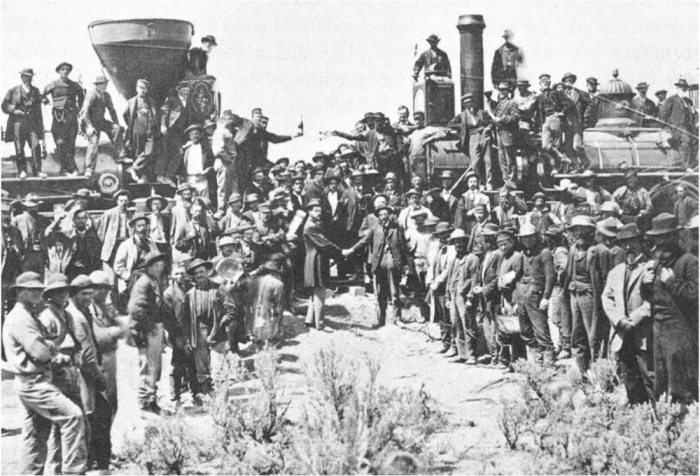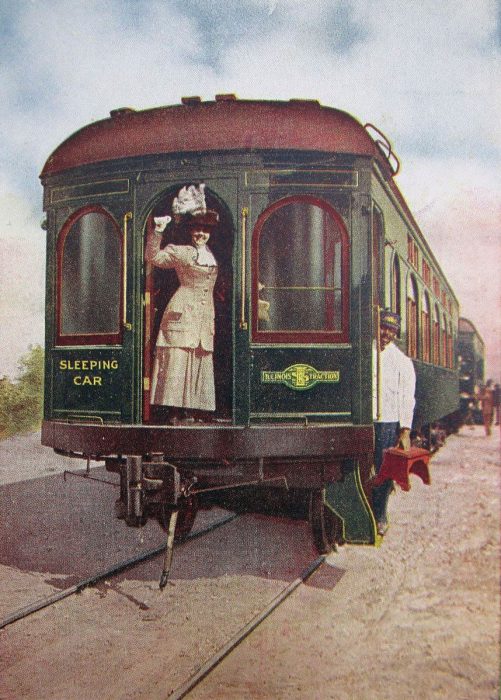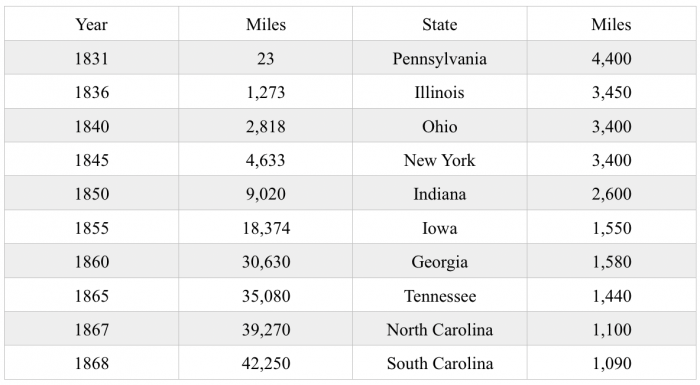Industrial Revolution (1800’s-1940’s)
43 The Transcontinental Railroad & the Pullman Car
Creation and Development of the Transcontinental Railroad
Evans Young; Evan Gaubert; and Samuel Bradley
Introduction
Without the railroad system, the industrialization and urbanization of cities in the United States would be very different today. The first official railroad was opened in Massachusetts in 1826, however, it was horse-drawn although the cars did function using tracks. Once gold was discovered in California, people began moving West in search of wealth and prosperity. People crossed mountains and valleys by horse-drawn carriages and on foot. This method of travel was very treacherous and dangerous, therefore another way of travel was needed. In 1862, in the midst of the Civil War, the Pacific Railroad Act was passed by Congress and signed by Abraham Lincoln. The passage of this act led the Central Pacific Railroad Company and the Union Pacific Railroad Company to construct a railroad that connected the West Coast to the Midwest. The first part of the Transcontinental Railroad was connected in Promontory, Utah on May 10, 1869, after seven years of construction. The Transcontinental Railroad relates to the topic of Science and Technology in Society because the railroad system advanced all of America and developed the Western United States by leading to the creation of factories. This led to economic prosperity in America. The Transcontinental Railroad system in America was a technological innovation that connected people and places across the nation; it directly led to the advanced development of the West, increased transportation and travel, and allowed for a more efficient system of trade and long-distance communication. It also impact the transportation of goods and allowed for them to be transported farther and faster. This allowed for the west to develop faster than it had previously.
Background
In 1849, gold was discovered in California. The word got around that many people were striking serious wealth, so numerous people left behind their lives in hopes of finding gold out West. The journey from the East to West was a difficult task; some traveled by boat around South America, and some traveled on horse and buggy across harsh terrains. People had to cross the Rocky Mountains, deserts, and rivers that divided the nation. In 1860, an engineer named Theodore Judah proposed an idea to build a railroad through a place called the Donner Pass in the Sierra Nevada mountains because it was nearly impossible to pass through. In 1861, Judah gathered a group of investors to further this idea. They created the Central Pacific Railroad Company. He proposed the Pacific Railroad Act to Congress and the bill was later passed by Congress and signed by Abraham Lincoln in 1862. The Pacific Railroad Act provided the money and land that the Pacific and Union Railroad Companies needed to build the Transcontinental Railroad. After the Pacific Railroad Company began building in Sacramento, California, the Union Pacific Company began building westward from the Missouri River in 1863. They planned to meet in the middle.
After the Pacific Railroad Act was passed and Judah obtained approval from Congress, the company was supported by four main investors: Charles Crocker, Leland Stanford, Collis Huntington, and Mark Hopkins. Although these private investors did not have any prior experience with railroads, engineering, and construction, they saw great potential in the idea of a transcontinental railroad system (Hall, 2012). The men in charge pushed the Chinese laborers to work through all seasons in extreme conditions in order to build bridges and drill through mountains to construct the railroad. On the other hand, the Union Pacific Company was quickly progressing West. Because this company had to build through Native American territories, the indigenous people became infuriated and began attacking the workers.
After years of construction and labor, the railroads were quickly coming together. The two companies ultimately decided to connect the tracks at Promontory Summit in Utah. The Pacific Railroad Company laid 690 miles of train tracks, while the Union Pacific Company built over 1,086 miles of track. On May 10, 1869, crowds gathered to watch the final spike, made of gold, being driven into the ground to connect the two railroads. This event is known as the Golden Spike Ceremony (History.com Editors, 2010)“The progress of railroads in this country is no doubt greater at this time than at any former period.” . “Our merchants, capitalists, manufacturers, tradesmen, legislators, and in fact, every class of people, are deeply interested in the railway system. It is of importance in the time of war: it is of still greater importance in the time of peace. The progress of railroads in this country is no doubt greater at this time than at any former period,” (The Bankers’ Magazine and Statistical Register, 1869). This quote emphasizes the importance of the major impact that the Transcontinental Railroad had on all of America.

The Invention of the Pullman Sleeping Car
The Transcontinental Railroad led to increased development across the country, and it also paved the way for increased travel and transportation in all areas of the United States. From the moment trains were first introduced to the innovation of the first sleeping car, travel by train was uncomfortable and inconvenient. People opted out of taking trains and instead began to travel through canals by boat. Something was needed to bridge the gap between comfortable and convenient travel. Thus, the first sleeping car was installed when the Cumberland Valley Railroad of Pennsylvania created a sleeping car service that ran between Harrisburg and Chambersburg (Husband, 22). It was an adaption of a regular day coach but had been redesigned to meet sleeping requirements. The sleeping car was divided into four compartments. In each compartment, there were three bunk beds, but they had mattresses without bed furnishings. A towel, basin, and water were also provided in the back of the car. The light was provided by candles and box stoves produced heat by burning wood or coal. The cars were nothing fancy, but the people at the time constantly marveled at the innovation (Husband, 24).
Growth of the Pullman Company
In the mid-1850s, George Pullman recognized the need for a more comfortable and efficient trainer, compared to the first sleeping car while traveling to New York. Due to his extensive experience working with boats on the Erie Canal, Pullman was able to construct an innovative sleeping car along with his business partner, Benjamin Field. Finally, in 1857, Pullman and Field were granted a contract from the Chicago, Alton, and St. Louis Railroads (Stamp, 2013). They began developing a more luxurious sleeping car. Field only remained in the train car business for a short period of time, before transitioning back to politics in exchange for future loans. Before the railroad, it took almost six months and cost $1000 to travel between California and New York. After the transcontinental railroad was completed, it cost $150 and took one week. For the first time, U.S. Americans could freely travel from coast to coast. This radically changed both business and pleasure travel (Endsley, 2014). In 1863, the first-ever sleeping car was produced. Pullman named the car the Springfield, and shortly after the second car was produced. Throughout the innovation of Pullman’s sleeping car, there were many obstacles, however, the company continued to expand and Pullman’s fortune rose exponentially.
Development of the pullman car
As the Pullman Company expanded, Pullman created the President. This train car was a sleeper with an attached kitchen and dining car. Shortly after the President was invented, Pullman produced a fine dining car called the Delmonico in 1868 (Stamp, 2013). As Pullman created more luxurious sleeping and dining cars, he changed the name of the company to Pullman Palace Car Company; this was approved by the Illinois Legislature in February of 1867. By 1869, the company had experienced extreme growth. Not only had Pullman innovated sleeping and dining cars, but he also created hotel cars, parlor cars, and reclining room cars. For the company to continue growing, Pullman bought out two of his competitors: Detroit Car and Manufacturing Company and Central Transportation Company. The invention of such train cars allowed for a more luxurious and comfortable way of travel. Due to these advancements, more and more people began traveling and United States culture became more unified because traveling became easier and more convenient.

How the Railroads Affected Trade
Finally, the Transcontinental Railroad benefitted the United States in that there was a major increase in trade volume between various cities nationwide. Due to the invention of the railroad, food, fuel, building materials, and raw materials were transported and further developed cities across the nation. As trade increased, the number of railroad tracks between cities increased as well.
Many aspects of modern society emerged during the building of the Transcontinental Railroad system. Connections between cities fueled urbanization and industrialization. This new mode of transportation also gave rise to suburbs because people could now commute to and from cities. The process of urbanization greatly increased the size of western cities and increased the proportion of city people to the total population. In 1840, no city west of the ninety-fifth meridian in the future United States had more than 5,000 residents, however, fifty years later, twenty cities in the western United States had populations of 20,000 or more (Abbott, 2011). Some cities, such as San Francisco, had populations of almost 300,000 people.

Not only did the railroads provide a new path to transport raw materials, but they also made long-distance communication much easier. On August 28, 1864, the Railway Post Office (RPO) system carried its first piece of mail. Sending packages and letters became more efficient and communication across the country was greatly improved. Special railroad cars were invented solely for mail carrying and delivery. Employees rode in the mail cars while sorting and handling the delivery of mail. The Railway Post Office system ended in the 1960s after the United States government pulled its mail contracts and began using other types of mail delivery. It was likely that wherever there was a railroad, there was a telegraph too, so messages and codes were able to be sent very quickly, thus improving communication.
Missing Voices
The construction of the Transcontinental Railroad is often celebrated as a triumph of American ingenuity and progress, yet the voices of thousands of Chinese immigrants who made this achievement possible are frequently overlooked. Between 1864 and 1869, an estimated 15,000 to 20,000 Chinese laborers worked under grueling and dangerous conditions to lay track through the Sierra Nevada Mountains and across the American West. Recruited by the Central Pacific Railroad Company, these workers performed some of the most difficult and perilous tasks, including blasting tunnels through solid granite, laying tracks across treacherous terrain, and enduring extreme weather conditions.
Despite their indispensable contributions, Chinese laborers faced systemic discrimination. They were paid less than their white counterparts, often receiving wages of $30 per month—about two-thirds of what white workers earned—while also having to cover their own food and lodging expenses. Unlike other workers, they were excluded from recognition during the Golden Spike Ceremony in 1869, which marked the completion of the railroad. Their labor, sacrifices, and even deaths—thousands perished in accidents, avalanches, and explosions—were largely erased from official histories for decades.
In recent years, efforts have been made to acknowledge the critical role of Chinese immigrants in building the railroad. Historical markers, academic research, and community-driven initiatives have worked to restore their place in history. The legacy of these laborers serves as a powerful reminder of how marginalized groups have shaped the technological and industrial advancements that transformed society, even when their contributions were long ignored.
Conclusion
The Transcontinental Railroad had a major impact in making America what it is today. It created a better way of transportation for all Americans because of how it was much faster, cheaper and safer than a horse and buggy. It also increased trade between cites and companies which helped them grow at a much faster pace. The Transcontinental Railroad system in America was a technological innovation that connected people and places across the nation; it increased transportation and travel, allowed for a more efficient system of trade and long-distance communication, and directly led to the advanced development of the West. Without the use of railroads in the United States, the nation would be very different today.
Chapter Questions
- True or False: The railroad went through all of the major cities in the United States, creating a better way for transportation across the nation.
- Short Response: What impact did the newfound railroad system have on the average American?
- Short Response: How did the railroads affect travel and transportation?
- Short Response: How did the railway post office impact the speed of mail?
AI USE DISCLOSURE
Chatgpt was used to assist me in giving me an outline to write this chapter
“Chatgpt.” ChatGPT, openai.com/chatgpt.
I used scite.ai in order to find sources for this chapter.
scite.ai. (2023). scite.ai (beta version) [Large Language Model]. https://scite.ai/assistant
References
Abbott, C. (2011). How cities won the West: four centuries of urban change in western North America. United States: University of New Mexico Press.
Central Pacific Railroad. (2019, August 28). Encyclopaedia Britannica. Retrieved November 12, 2019, from https://www.britannica.com/topic/Central-Pacific-Railroad.
Editors of Publications International, Ltd. (2008, May 19). Railroad Expansion. Retrieved from https://history.howstuffworks.com/american-history/railroad-expansion9.htm.
Endsley, C. (2014, December 17). How the Transcontinental Railroad Changed America. Retrieved October 21, 2019, from https://gtgtechnologygroup.com/transcontinental-railroad/.
Four Special Spikes. (2019, March 28). Retrieved from https://www.nps.gov/gosp/learn/historyculture/four-special-spikes.htm.
George Pullman. (n.d.). Retrieved November 12, 2019, from https://lemelson.mit.edu/resources/george-pullman.
Hall, L. (n.d.). The Pacific Railway. Retrieved from https://railroad.lindahall.org/essays/brief- history.html.
History.com Editors. (2010, April 20). Transcontinental Railroad. Retrieved from https://www.history.com/topics/inventions/transcontinental-railroad.
Husband, J. (2015). The story of the Pullman car. Place of publication not identified: Forgotten Books.
Pacific Railway Acts. (2019, July 2). Encyclopaedia Britannica. Retrieved November 12, 2019, from https://www.britannica.com/event/Pacific-Railway-Acts.
Hubbard, G. G. (1887). The Transcontinental Railroads. Science, 10(241), 133–137.
http://www.jstor.org/stable/1763868
Public Broadcasting Service. (n.d.). The impact of the Transcontinental Railroad. PBS. http://www.pbs.org/wgbh/americanexperience/features/tcrr-i mpact-transcontinental-railroad/
Pullman Palace Car Company. (2019, November 10). Retrieved from https://www.encyclopedia.com/history/encyclopedias-almanacs-transcripts-and-maps/pullman-palace-car-company.
The Railroads of the United States.: Manual of the Railroads of the United States for 1869-70… (1869). The Bankers’ Magazine and Statistical Register (1849-1894), 4(2), 81. Retrieved from http://libproxy.clemson.edu/login?url=https://search-proquest-com.libproxy.clemson.edu/docview/124435765?accountid=6167
Railway Post Office (RPO). (n.d.). Retrieved November 12, 2019, from https://www.american-rails.com/rpo.html.
Rand Mcnally And Company & Union Pacific Railway Company. (1883) New map of the Union Pacific Railway, the short, quick and safe line to all points west. [Chicago] [Map] Retrieved from the Library of Congress, https://www.loc.gov/item/98688838/.
Union Pacific Railroad Company. (2019, August 28). Encyclopaedia Britannica. Retrieved November 12, 2019, from https://www.britannica.com/topic/Union-Pacific-Railroad-Company.
Wilson, M. A. (1954). American science and invention, a pictorial history; the fabulous story of how American dreamers, wizards, and inspired tinkerers converted a wilderness into the wonder of the world. New York: Bonanza Books.
Zwonitzer, M. (n.d.). The Transcontinental Railroad. Retrieved from https://www.pbs.org/wgbh/ americanexperience/films/tcrr/#film_description.
images
“East and West Shaking Hands at Laying Last Rail”” by Andrew Joseph Russell, Yale University Library is in the Public Domain
“Illinois Traction sleeping car” by Illinois Traction System is in the Public Domain

